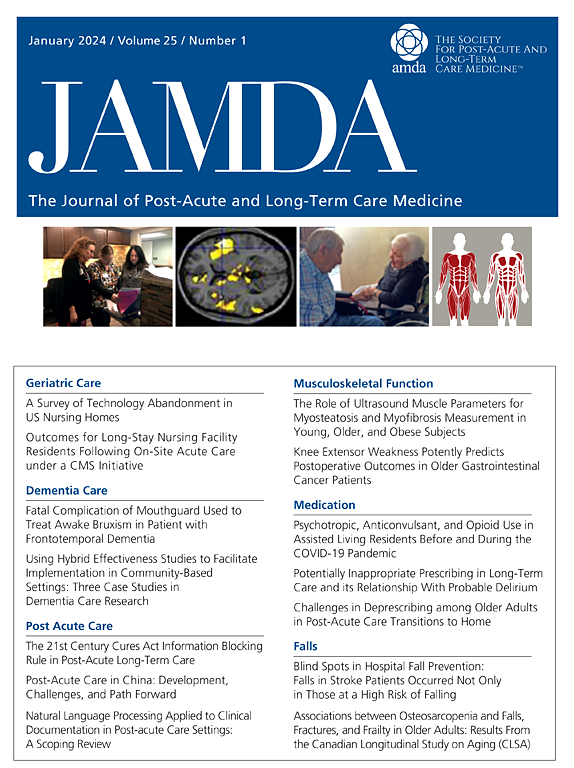Association Between Nursing Home Five-Star Ratings and Consumer Satisfaction
IF 4.2
2区 医学
Q2 GERIATRICS & GERONTOLOGY
Journal of the American Medical Directors Association
Pub Date : 2024-10-19
DOI:10.1016/j.jamda.2024.105322
引用次数: 0
Abstract
Objective
Consumers can currently access the Centers for Medicare and Medicaid Services Five-Star Quality Rating System when they choose a nursing home (NH). However, the system does not incorporate NH consumers’ opinions. Without having access to satisfaction or quality-of-life measures, consumers could make uninformed decisions. This study aims to investigate the association between five-star ratings and family/resident satisfaction scores.
Design
Secondary data analysis was used.
Setting and Participants
A unique, NH-level dataset of Ohio NHs that contains star ratings, satisfaction scores, and NH characteristics was constructed (N = 701). Data were drawn from the 2018 star rating data, 2018 Ohio Nursing Home Family Satisfaction Survey, 2017 Ohio Nursing Home Resident Satisfaction Survey, 2017 Ohio Biennial Survey of Long-Term Care Facilities, and the Certification and Survey Provider Enhanced Reports.
Methods
Chi-square and logistic regression analyses were conducted controlling other NH characteristics.
Results
Chi-square results showed consumer satisfaction and star ratings were correlated, but imperfectly related. Regression results found that NHs with higher family satisfaction score received significantly higher star ratings across all domains except the quality-measure star rating. For each 1% point increase in the family satisfaction score, the probability of being a 4 or 5 overall star NH increases by 1.1% point (P < .01), and being a 4 or 5 health inspection star NH increases by 1.2% points (P < .01). NHs with higher resident satisfaction score received significantly higher star ratings. For every 1% point increase in the resident satisfaction score, the probability of being a 4 or 5 star NH increases by 0.7% point (P < .05) across all star ratings.
Conclusions and Implications
Early studies found little relationship between five-star ratings and consumer satisfaction scores. This study found consumer satisfaction is associated, although imperfectly, with star ratings. This highlights the need to publicly report NH consumer perspectives to help them make informed care decisions.
养老院五星评级与消费者满意度之间的关系。
目标:目前,消费者在选择养老院(NH)时,可以访问医疗保险和医疗补助服务中心的五星级质量评级系统。然而,该系统并不包含 NH 消费者的意见。由于无法获得满意度或生活质量的衡量标准,消费者可能会在不知情的情况下做出决定。本研究旨在调查五星评级与家庭/住户满意度得分之间的关联:设计:采用二级数据分析:构建了一个独特的俄亥俄州 NH 级数据集,其中包含星级评定、满意度评分和 NH 特征(N = 701)。数据来自 2018 年星级评定数据、2018 年俄亥俄州养老院家庭满意度调查、2017 年俄亥俄州养老院居民满意度调查、2017 年俄亥俄州两年一次的长期护理机构调查以及认证和调查提供方增强报告:方法:在控制其他 NH 特征的基础上进行卡方分析和逻辑回归分析:卡方分析结果显示,消费者满意度与星级评定存在相关性,但并非完全相关。回归结果发现,家庭满意度得分较高的 NH 在除质量测量星级评定外的所有领域获得的星级评定都明显较高。家庭满意度得分每增加 1%,成为 4 至 5 级综合星级 NH 的概率就会增加 1.1%(P < .01),成为 4 至 5 级健康检查星级 NH 的概率就会增加 1.2%(P < .01)。居民满意度较高的养老院获得的星级评分明显更高。在所有星级评定中,居民满意度得分每增加 1%,成为 4 至 5 星级 NH 的概率就会增加 0.7% 点(P < .05):早期研究发现,五星评级与消费者满意度得分之间关系不大。本研究发现消费者满意度与星级评定之间存在关联,尽管这种关联并不完美。这凸显了公开报道NH消费者观点的必要性,以帮助他们做出明智的医疗决策。
本文章由计算机程序翻译,如有差异,请以英文原文为准。
求助全文
约1分钟内获得全文
求助全文
来源期刊
CiteScore
11.10
自引率
6.60%
发文量
472
审稿时长
44 days
期刊介绍:
JAMDA, the official journal of AMDA - The Society for Post-Acute and Long-Term Care Medicine, is a leading peer-reviewed publication that offers practical information and research geared towards healthcare professionals in the post-acute and long-term care fields. It is also a valuable resource for policy-makers, organizational leaders, educators, and advocates.
The journal provides essential information for various healthcare professionals such as medical directors, attending physicians, nurses, consultant pharmacists, geriatric psychiatrists, nurse practitioners, physician assistants, physical and occupational therapists, social workers, and others involved in providing, overseeing, and promoting quality

 求助内容:
求助内容: 应助结果提醒方式:
应助结果提醒方式:


